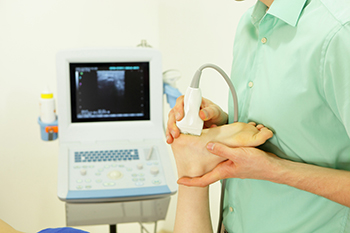Chronic venous insufficiency is a condition in which the walls and valves of veins in the lower limbs do not function properly. This causes excessive pooling of blood in the lower limbs, resulting in heaviness, tension, swelling, aching, and cramping in the lower legs. One way to diagnose chronic venous insufficiency is through a venous Doppler ultrasound, which uses sound waves to show what the blood flow in the lower legs looks like. Ultrasounds are fast, safe, painless, and provide a great deal of data to help your doctor determine the correct diagnosis and monitor the health of your lower limbs. For more information about chronic venous insufficiency, please consult with a podiatrist.
Vascular testing plays an important part in diagnosing disease like peripheral artery disease. If you have symptoms of peripheral artery disease, or diabetes, consult with one of our podiatrists from Advanced Foot & Ankle Medical Center . Our doctors will assess your condition and provide you with quality foot and ankle treatment.
What Is Vascular Testing?
Vascular testing checks for how well blood circulation is in the veins and arteries. This is most often done to determine and treat a patient for peripheral artery disease (PAD), stroke, and aneurysms. Podiatrists utilize vascular testing when a patient has symptoms of PAD or if they believe they might. If a patient has diabetes, a podiatrist may determine a vascular test to be prudent to check for poor blood circulation.
How Is it Conducted?
Most forms of vascular testing are non-invasive. Podiatrists will first conduct a visual inspection for any wounds, discoloration, and any abnormal signs prior to a vascular test.
The most common tests include:
- Ankle-Brachial Index (ABI) examination
- Doppler examination
- Pedal pulses
These tests are safe, painless, and easy to do. Once finished, the podiatrist can then provide a diagnosis and the best course for treatment.
If you have any questions, please feel free to contact our office located in Thousand Oaks, CA . We offer the newest diagnostic and treatment technologies for all your foot care needs.





